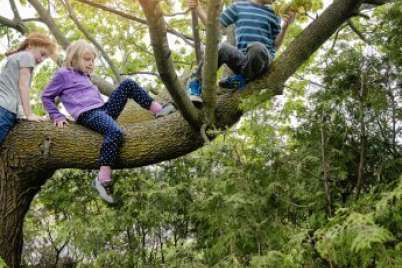
How to create a nature mandala on your walks this winter
Walking is a fabulous activity. And winter walking is great—no humidity, bugs, or mud. While adults might be keen to let our minds wander during a long ramble, or even practice a walking meditation, kids might need more of a mission to keep them engaged—or to even agree to the activity.
Enter mission: Nature mandalas, a simple yet rewarding activity for kids ages three and up. Added bonus: This is an experience that immerses the participants in nature.

Materials required:
- A bag to collect found/fallen objects in nature
- Pruners to cut found/fallen objects (for adult use only)
- Nature—a park, beach, playground, forest, or conservation area
Step 1: Prepare
Before leaving for the walk, do a quick online search of nature mandalas to spark excitement in the activity and to provide a visual reference of the sorts of materials to look for.
Step 2: Start walking
Pick an age-appropriate distance. You may need to spend up to 30 minutes walking over a variety of terrains in nature a find a diverse array of materials.
Step 3: Be on the lookout
Look for fallen objects in a variety of colours, textures, and materials. Great mandala-building materials include:
- Pinecones
- Small fallen evergreen boughs or branches
- Long pine needles
- Sumac berries
- Cattails
- Dried flowers, grasses or plants
- Berries, like mountain ash berries
- Rocks of all sizes
- Fallen bark
- Dogwood
- Sticks of varying sizes
- Leaves that aren’t decomposed
- Moss
- Driftwood
- Shells

Step 4: Say yes to most items
Use the pruners to cut down larger fallen branches into manageable pieces. Remember not to cut anything from a living plant or tree, but you can take a few dead flower heads (leave the rest as cover for wildlife). Make sure the adults handle the berries to prevent inquisitive youngsters from sampling them.
Step 5: Assess the haul
Once you have been walking for a while and have a good collection, inspect your findings. Ask yourself:
- Is there a good variety of colours? What do you see?
- Do we have different textures represented? What do you feel?
- Are there a variety of plants, trees, and minerals? What does each smell like?
Step 6: Find an open space to create the mandala
Now, you need a canvas. A swath of unmarked snow is ideal, but you can also use a patch of grass, a frozen ice surface, sand, a clear part of beach, a patio, deck, driveway, or the sidewalk.
Step 7: Start creating
Most mandalas are circles and often incorporate spirals or other patterns, but let your imagination run wild. You could create a shape like a peace sign or even try to design a bird, fish, or tree. Use a variety of materials and try to contrast colours to make details pop. Use rocks to weigh down some of the lighter materials in case of a wind gust.

Step 8: Stand back and admire the creation
Be sure to take some photos. You could even leave a note weighed down by a rock explaining that the artscape was created using only fallen objects along a nature walk and challenge the finder to do the same. This would create a great ripple effect of activity and artistry.
Winter walks are great, but sometimes it’s nice to have a specific goal in mind. This activity also appeals to the artistic kids who just love to create. Remember to teach respect for nature and safety with found objects.
Next steps: Make a series of mandalas or artistic creations, take a photo each time, and create a collage or an album! Challenge the family to complete a series of walks and mandalas every month throughout the changing seasons. Keep moving, and keep creating!






This will surely awaken my creative spirit- thanks for this 🙏🌎
You’re welcome! Thank you for the comment!
My twin grandkids love collecting found nature bits when we walk. We take it home and make collages. I had not thought about taking it home and making a mandala out of it. Very cool. I think it is important to acknowledge that taking ‘bits’ that are found, is different from taking cuttings. Thank You for the idea. : )
Make sure you have the park’s permission to do this. Many conservation and wilderness areas do not allow any harvesting, moving or altering any of the flora, fauna, rocks & shells. Bringing in items outside of the park also risks the chance of transporting invasive and non-native species. Building cairns, (stacking rocks) for example, can greatly affect fragile macro invertebrate habitats. Remember, you don’t want others coming into your home and redecorating, moving your stuff around or taking what’s yours…Nature deserves the same respect.
There is no mention of a park in this article. Lots of people still own land. And I can’t get over the unrealness of people who think moving a rock or rocks is a crime against nature.
Agree
Agree if on private land but not on state park etc
Very cool idea! Thanks for all the great tips!